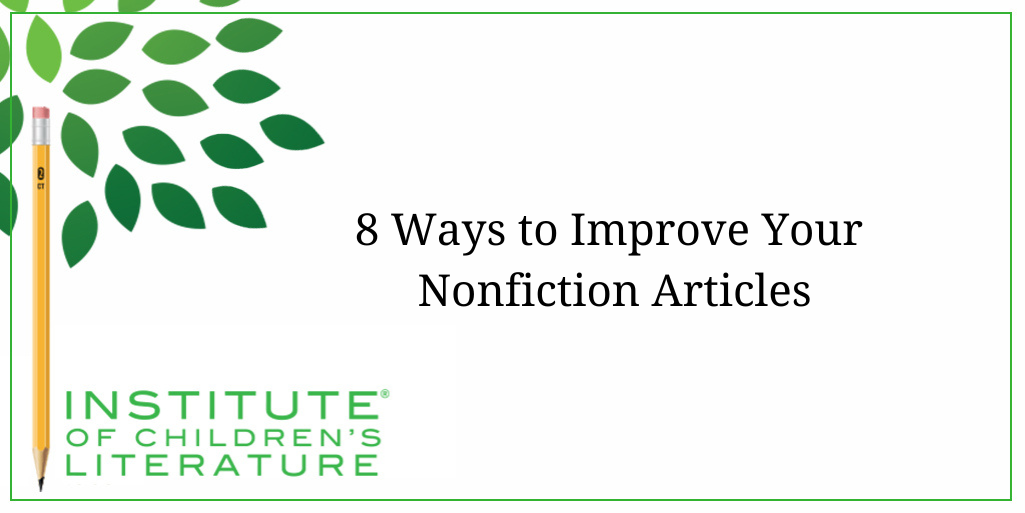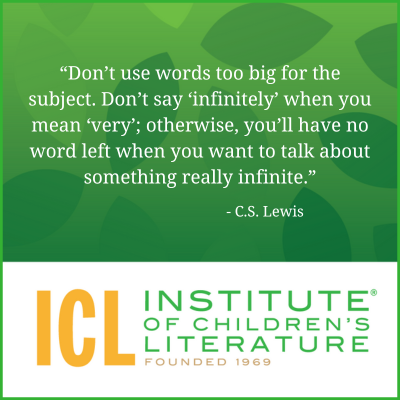
8 Ways to Improve Your Nonfiction Articles
Publishers know that young people are hungry for good nonfiction. Let’s look at eight ways you can spruce up your nonfiction article writing.

Nonfiction article writing suffers from bad press. Beginning writers think it’s probably boring, and that kids would rather not read it. Interestingly enough, that isn’t true at all. Many kids love nonfiction. For some, it’s preferred over fiction. That’s why so many magazines for young people are full of nonfiction articles.
 1. Pay Attention to Your Voice
1. Pay Attention to Your VoiceGood nonfiction has voice. That doesn’t mean you’re going to lean into some folksy, rambling voice for your article on the start of the Civil War, but it does mean that you can make choices about your words, your pacing, your sentence structures, and more that contribute to the voice in your nonfiction. You can choose strong verbs. You can make accurate, but unexpected analogies.
For instance, what if you didn’t lean on the old “the heart is a pump” and went instead for “the heart is like the sack in a set of bagpipes?” Readers would be surprised and potentially amused, and that means they’ll be paying attention to what you have to say. That’s the value of voice. It gets the reader’s attention. And if you’re going to impart information that sticks in the head of the reader, getting their attention is a good first step.
Speaking of readers, don’t forget to give your reader some thought. In children’s writing, nothing is written “for all ages.” Someone may try to market your piece to people of all ages, but a well-written piece focuses on a specific reader group. This allows you to focus your voice and your information.
For example, if I’m writing about tiny robots. and I’m picturing a child of eight, I will go into the article with certain knowledge. I’ll know the child is eager to read about robots. This is an age group that adores nonfiction. So, I don’t need to cajole or slip into an insultingly chipper voice. Instead, I can let my excitement for the topic shine through my writing. (And if I’m not excited about the topic, why would I be writing about it?)
I will think about what an eight-year-old knows right now. That’s important so I don’t talk down to the reader or talk over their head. Too many times, writers who are trying to write for “every kid” will jump between talking down and talking over throughout the piece because the writer never gave thought to a specific reader. That kind of writing will always get rejected. Think about your reader at every step and you’ll automatically make better choices as you write.
Most nonfiction articles for kids have a very narrow focus, but that doesn’t mean you don’t need much research. Good research is essential for good nonfiction.

I want my nonfiction articles to be more than bare facts. I want each one to have a big idea, something that lingers after the last word is read. And I find that in deep research. Plus, the more I dig deep, the more I become passionate about the topic. The more I’m an expert, the more excitement I’ll carry to the reader. Writing an article isn’t simply an exercise. It’s a way to give the reader something profound. I simply have to keep digging until I find something I want to present. By researching deeply, I’ll have a ton of information that I won’t use, but I’ll also find those specific gems that dazzle.
Most revisions of nonfiction articles are about organization. Many writers like to write organically. They research deeply, but then they write as the excitement leads them. This has value. You can sometimes find you’re changing focus and heading in new and surprising directions. It can change everything for the better.
But, organic writers need to be organized revisers, because nonfiction is organized writing. It must be. Otherwise, readers won’t understand what you’re telling them. It must be so readers can come out of the reading with fresh knowledge. It must be to keep the reader engaged from beginning to end. So, be sure you are grouping information logically. As you move from one part of the article to the next, use clear transitions to keep the reader from getting lost.
The key to organization is setting goals. Think about what you ultimately want to accomplish with this article. Do you want to alert the reader to a problem in the world? That will mean you need to explain the problem. Show why it is a problem. Show who is affected by the problem. And show what we might do about it.
Just by thinking about what you need to accomplish, you’ll begin to see the best way to organize the information. The information will begin to group itself if you spend some time planning that organization. This planning for organization can happen before you write, or it can happen after the first draft and before you begin the first rewrite. [Because a draft that doesn’t have a planned organization won’t need polishing. It will need rewriting. And that’s fine. It’s part of writing something that works.]
 5. There’s A Signpost Up Ahead
5. There’s A Signpost Up AheadAs we talk about organization, there is one wonderful tool available to nonfiction writers: subheadings. Subheadings are a way of labeling the parts of the article. In this essay, for example, I’m using a numbered list of tips as subheadings. This gives me a clear and easy way to organize. I thought about the best order to present the tips, and then I let the tip list become my subheadings. Under each subheading, I grouped information that fit that subheading.
This works for kid’s nonfiction too. Both nonfiction books and nonfiction articles often employ subheadings. The subheadings can be clever (which editors like) or strictly labels for what you’ll find under them. Not only do subheadings help you keep your material organized, they also help the reader zero in on the parts of the article of most interest. They can also be useful for kids using your nonfiction as a source for a school report. The subheadings let them easily find the part they want to quote. I often begin with very label-oriented subheadings, and then try to revise for more voice or a clever turn of phrase after the first draft.
Good sources make for better nonfiction. All sources are not created equal, and this is especially true of online sources. Most of us know to avoid using Wikipedia as a source. The nature of Wikipedia depends heavily on the wisdom of the crowd. It can be a great jumping-off point for getting a first overview of a topic, but you can’t count on the accuracy of the content. Still, the articles on Wikipedia have source lists that can be potentially helpful. So I always like to check to see if there is a source I want to check out.
When I think about good sources, I’m looking for a couple things. I want to know who wrote the information I’m considering. Is this person an expert? If not, are they telling me where they got their information? Sometimes things you find online are the result of very shallow scholarship.
For example, if you have an interest in beetles, you can find both very good information online (articles from scholarly journals for example) and very dubious information (cute fact lists from homeschool science groups). The dubious source might have gotten the information right, or they might not. I can’t tell, so I can’t trust the information. Also, I’m going to consider whether whoever put information online has an agenda.
For example, if I’m writing about food safety, and I find information telling me that food is safer to eat now than ever before, I will want to know how the writer came to that conclusion. And if I discover the piece is on a website sponsored by a major food company, I have to consider that the website has an agenda. That needs to make me double or even triple-check anything they say. When in doubt, throw the source out. You must be sure you can trust the accuracy of what you’re passing on.
Direct quotes can be great. They can give a sense of the person speaking. They can add flavor to your writing. For example, if I quote from a letter written home by a soldier in the Civil War, I’m offering the reader a peek into the past. The reader is seeing something written at the very moment I’m talking about in the article. Also, quotes can increase your trustworthiness to the reader. They see your scholarship because you’re quoting a source directly.

The problem with that is that my readers weren’t likely to understand the quote any better than I did. It was lazy quoting. It was published, but it definitely wasn’t my finest hour. Any quote you use needs to be something you understand. It should also bring something to the piece in terms of voice or immediacy that paraphrasing wouldn’t have offered. It needs to be quoted because the quote adds value to the piece for the reader.
Two of the most important nonfiction articles are the beginning and the end. The beginning is when you make your promise to the reader. The end is when you give the reader something that lingers on the way out. The beginning grabs the reader’s attention, while the ending lets the reader go, fully satisfied with the reading experience. The beginning and ending are the moments you set your voice and speak for the last time to that reader. When they are done right, they sandwich the content perfectly and become key to making an editor sit up and take notice.
Most writers spend a respectable amount of time on beginnings, but even after the article is written, return to your beginning. Ask yourself: does the article I have written fulfill the promise I made at the beginning? In other words, does the beginning still seem to introduce the article I actually wrote? If not, either the article needs to change or the beginning does.
Endings usually get much less attention than beginnings. But every article needs an ending. Now it doesn’t necessarily need to be more than a single sentence. Sometimes a sentence is all you need to bring the article to a close. This is especially true if your ending is simply some pithy summation of the contents, showing you fulfilled the promise of the beginning.
A last sentence might be some kind of wordplay and intended to leave the reader with a smile. But it does need an ending. Something you can point at and say, “That’s my ending.” The end isn’t simply the moment when you run out of things to say. That kind of ending is like a sentence with no punctuation. It feels unfinished. It’s famous last words without the words. Don’t leave your article hanging like that. It deserves better, and you can give it better.
Are these eight things the only tips you need to craft a great article? Probably not. But they’ll help. If you do these eight things right, you’re probably going to have an interesting and engaging article. And with that, you’re probably going to have a sale. What more do we need than that?
With over 100 books in publication, Jan Fields writes both chapter books for children and mystery novels for adults. She’s also known for a variety of experiences teaching writing, from one session SCBWI events to lengthier Highlights Foundation workshops to these blog posts for the Institute of Children’s Literature. As a former ICL instructor, Jan enjoys equipping writers for success in whatever way she can.

Publishers know that young people are hungry for good nonfiction. Let’s look at eight ways you can spruce up your nonfiction article writing.

Writing an effective nonfiction article ending is one of the most overlooked aspects of writing. Leave your reader satisfied with these riveting resolutions!

One of the best ways to learn what makes an engaging article opening is to study published nonfiction pieces and to see what made them successful. Let’s do it!
1000 N. West Street #1200, Wilmington, DE 19801
© 2024 Direct Learning Systems, Inc. All rights reserved.

1000 N. West Street #1200, Wilmington, DE 19801
© 2024 Direct Learning Systems, Inc. All rights reserved.

1000 N. West Street #1200, Wilmington, DE 19801
©2024 Direct Learning Systems, Inc. All rights reserved. Privacy Policy.